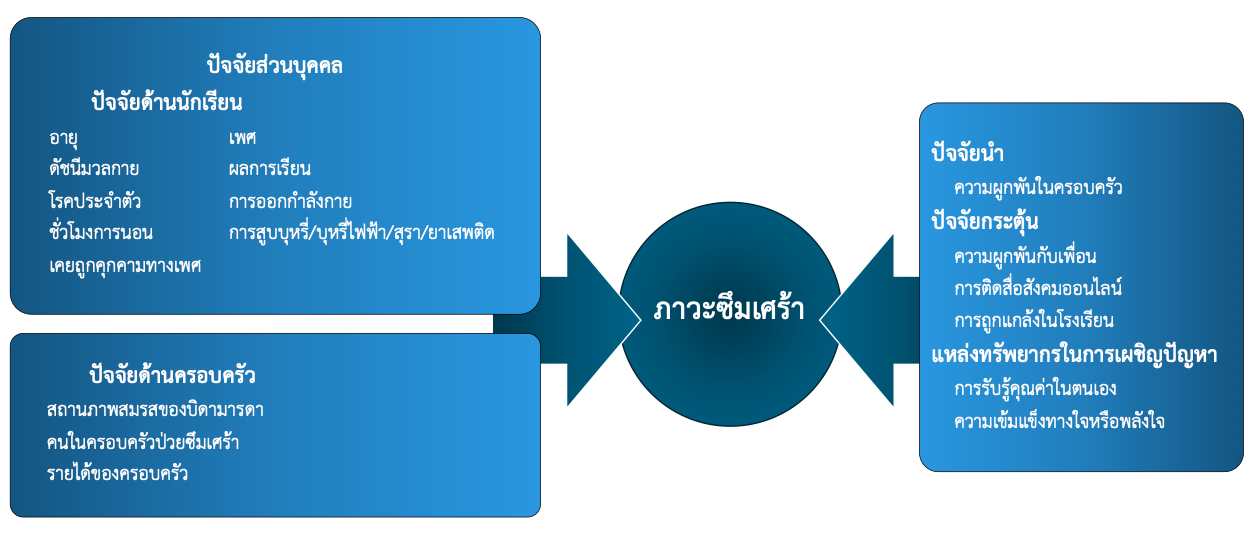Factors Associated with Depression In High School Students in Pakphanang District, Nakhon Si Thammarat Province
Main Article Content
Abstract
This cross-sectional descriptive study aimed to investigate factors associated with depression among high school students in Pak Phanang District, Nakhon Si Thammarat Province. A total of 240 study samples were randomly selected using stratified random sampling. The research instrument was a questionnaire consisting of 8 sections: 1) personal information, 2) family ties, 3) friendship ties, 4) bullying, 5) social media addiction, 6) motivation or mental strength, 7) self-esteem, and 8) a depression screening questionnaire (The Thai version of the Patient Health Questionnaire for Adolescents: PHQ-A). Data analysis was carried out using descriptive statistics including numbers, percentages, means and standard deviations, and inferential statistics including Chi-square and binary logistic regression. The research findings revealed that the sample group had depression in total of 87 people (36.25%). Of the sample group with depression, 84 people (35%) were found to have the opportunity to commit suicide, with 23 people (9.58%) being in the high-risk group. The group with depression had the opportunity to commit suicide as high as 11.94 times when compared to the group without depression. The results of the multivariate analysis related to depression indicated 4 important variables: having low family bonding was 5.17 times more likely to have depression than the group with high family bonding (95% CI: 1.459-18.32, p-value<0.01), being bullied at school was 2.43 times more likely to have depression than the group that was not bullied (95% CI: 1.151-5.118, p-value=0.02), having low willpower was 4.60 times more likely to have depression than the group with high willpower (95% CI: 1.066-19.842, p-value =0.041), and having low self-esteem had a chance of developing depression 11.90 times, compared to the high self-esteem group (95% CI: 2.132-66.382, p-value < 0.01).
Article Details

This work is licensed under a Creative Commons Attribution-NonCommercial-NoDerivatives 4.0 International License.
The articles published in this academic journal are copyrighted by the Office of Disease Prevention and Control Region 11, Nakhon Si Thammarat.
The views and opinions expressed in each article are solely those of the respective authors and do not reflect the opinions or positions of the Office of Disease Prevention and Control Region 11, Nakhon Si Thammarat, or its personnel. The authors are fully responsible for the content of their respective articles. In the event of any errors, the authors alone assume full responsibility for their works.
Reproduction of all or part of any article is strictly prohibited unless prior permission has been obtained from the journal editorial board.
This statement is intended for publication on the official website of the academic journal of the Office of Disease Prevention and Control Region 11, Nakhon Si Thammarat.
References
Stuart GW. Principles and practice of psychiatric nursing. 10th ed. St. Louis: Elsevier Mosby; 2013.
ศุทรา เอื้ออภิสิทธิ์วงศ์. การศึกษาความสัมพันธ์ระหว่างสัมพันธภาพในครอบครัวและภาวะซึมเศร้าในวัยรุ่น. วารสารสุขภาพจิตแห่งประเทศไทย. 2563;28(3):231–9.
วิศิษฎ์ ฉวีพจน์กำจร, ณัฐจาพร พิชัยณรงค์, วรณัน อรรถแสงศี, ปรารถนา สถิตวิภาวี, ชฎา ประเสริฐทาง. ปัจจัยทางสังคมกับภาวะซึมเศร้าในกลุ่มนักเรียนมัธยมศึกษาตอนปลาย. วารสารวิทยาศาสตร์และเทคโนโลยี มหาวิทยาลัยมหาสารคาม. 2016;35(5):530–7.
Klomek AB, Kleinman M, Altschuler E. High school bullying as a risk for later depression and suicidality. Suicid Life Threat Behav. 2011;41:501–16.
รัตนา มาฆะสวัสดิ์. ปัจจัยที่มีอิทธิพลต่อภาวะซึมเศร้าของนักเรียนมัธยมศึกษาตอนปลายในจังหวัดปทุมธานี. วารสารศูนย์อนามัยที่ 9. 2564;15:528–40.
เทิดศักดิ์ เดชคง. ความตรงและความเชื่อมั่นของแบบประเมินพลังใจฉบับ 3 ข้อ. วารสารสุขภาพจิตแห่งประเทศไทย. 2565;30(4):297–306.
วิมลวรรณ ปัญญาว่อง, รัตนศักดิ์ สันติธาดากุล, โชษิตา ภาวสุทธิไพศิฐ. ความชุกของภาวะซึมเศร้าและความเสี่ยงฆ่าตัวตายในวัยรุ่นไทย การสำรวจโรงเรียนใน 13 เขตสุขภาพ. วารสารสุขภาพจิตแห่งประเทศไทย. 2563;28(2):136–49.
สุนันท์ เสียงเสนาะ, ดวงใจ วัฒนสินธุ์, ภรภัทร เฮงอุดมทรัพย์, เวทิส ประทุมศรี. อิทธิพลของปัจจัยด้านสัมพันธภาพระหว่างบุคคลต่อภาวะซึมเศร้าของวัยรุ่นตอนปลาย. วารสารวิทยาลัยพยาบาลบรมราชชนนี กรุงเทพ. 2560;33(3):59–69.
สุจิตรา อู่รัตนมณี, สุภาวดี เลิศสำราญ. ความเครียด ความวิตกกังวล และภาวะซึมเศร้าของนักเรียนวัยรุ่นที่เตรียมตัวสอบคัดเลือกเข้ามหาวิทยาลัย. วารสารการพยาบาลจิตเวชและสุขภาพจิต. 2560;31(2):78–93.
ศูนย์วิจัยและสารสนเทศโรคซึมเศร้า, กรมสุขภาพจิต. รายงานการเข้าถึงบริการของผู้ป่วยโรคซึมเศร้าปีงบประมาณ 2567 เดือนกุมภาพันธ์-ธันวาคม [อินเทอร์เน็ต]. 2567 [สืบค้นเมื่อ 8 กุมภาพันธ์ 2568]. แหล่งข้อมูล: https://thaidepression.com/www.report/main_report/
กรมสุขภาพจิต, กระทรวงสาธารณสุข. ข้อมูลการประเมินสุขภาพจิตเด็กและวัยรุ่นเขตสุขภาพที่ 11 [อินเทอร์เน็ต]. 2568 [สืบค้นเมื่อ 8 กุมภาพันธ์ 2568]. แหล่งข้อมูล: https://catalog.dmh.go.th/ dataset/mental-child-11/resource/82b49c26-19c2-4ae7-a11f-3c087c7a8d80
วิมลวรรณ ปัญญาว่อง, โชษิตา ภาวสุทธิไพศิฐ, รัตนศักดิ์ สันติธาดากุล. รายงานการวิจัยเรื่องพัฒนาแบบประเมินภาวะซึมเศร้าในวัยรุ่น [Development of the Thai version of the Patient Health Questionnaire for Adolescents (PHQ-A)]. กรุงเทพฯ: บียอนด์ พับลิชชิ่ง; 2561.
สำนักงานกองทุนสนับสนุนการสร้างเสริมสุขภาพ (สสส.). คู่มือแบบประเมินระดับสัมพันธภาพของครอบครัว [อินเทอร์เน็ต]. 2566 [สืบค้นเมื่อ 8 กุมภาพันธ์ 2568]. แหล่งข้อมูล: http://happychild.thaihealth.or.th/wp-content/uploads/sites/28/2023/03/คู่มือแบบประเมินสัมพันธภาพของครอบครัว.pdf
มัณฑนา นทีธาร. ปัจจัยที่มีอิทธิพลต่อภาวะซึมเศร้าของเด็กวัยรุ่นในอำเภอเมือง จังหวัดเชียงใหม่. [วิทยานิพนธ์พยาบาลศาสตรมหาบัณฑิต]. เชียงใหม่: มหาวิทยาลัยเชียงใหม่; 2547.
ชาญวิทย์ พรนภดล, คณะ. แบบทดสอบการติดสื่อสังคมออนไลน์ (Social Media Addiction Test: SMAT) [อินเทอร์เน็ต]. [สืบค้นเมื่อ 18 กุมภาพันธ์ 2567]. แหล่งข้อมูล: http://www.cumen-talhealth.com/ index.php?lay=show&ac=article&Id=539909352
สมบัติ ตาปัญญา. รายงานการสำรวจปัญหาการรังแกกันของนักเรียน. เชียงใหม่: คณะแพทยศาสตร์ มหาวิทยาลัยเชียงใหม่; 2549.
ผ่องศรี ศรีมรกต. ผลของการให้คำปรึกษาแบบประคับประคองต่อการรับรู้ภาวะเจ็บปวด ระดับความรู้สึกมีคุณค่าแห่งตน และขวัญกำลังใจในผู้ป่วยมะเร็งปากมดลูกที่ได้รับรังสี [วิทยานิพนธ์ดุษฎีบัณฑิต]. กรุงเทพฯ: มหาวิทยาลัยมหิดล; 2536.
เทิดศักดิ์ เดชคง, คณะ. ความตรงและความเชื่อมั่นของแบบประเมินพลังใจฉบับ 3 ข้อ. วารสารสุขภาพจิตแห่งประเทศไทย. 2565;30(4):297–306.
วิลาสินี สุราวรรณ์. ความชุกและปัจจัยที่มีความสัมพันธ์กับภาวะซึมเศร้าของนักเรียนมัธยมศึกษาตอนต้น อำเภอน้ำพอง จังหวัดขอนแก่น. วารสารสมาคมจิตแพทย์แห่งประเทศไทย. 2564;66:403–16.
วราวรรณ สุทธิประภา, คณะ. ความชุกและปัจจัยที่เกี่ยวข้องกับภาวะซึมเศร้าในนักเรียนมัธยมศึกษาเขตอำเภอเมืองเพชรบูรณ์. วารสารวิทยาศาสตร์สุขภาพ วิทยาลัยพยาบาลบรมราชชนนี สรรพสิทธิประสงค์. 2567;8(1):1-16.
Restifo K, Bogels S. Family processes in the development of youth depression: translating the evidence to treatment. Clin Psychol Rev. 2009;29:294–316. doi:10.1016/j.cpr.2009.02.005.
รัตนภูมิ วัฒนปัญญาสกุล. อิทธิพลของความสัมพันธ์ในครอบครัวต่อภาวะซึมเศร้าในนักเรียนวัยรุ่นที่โรงเรียนสาธิตศรีนครินทรวิโรฒประสานมิตร. วารสารสมาคมจิตแพทย์แห่งประเทศไทย. 2564;66(4):417–28.
Ngoc L, et al. Cyber-bullying among adolescents at school: a literature review. Int J Psychosoc Rehabil. 2020;24(7):9700–12.
Li C. The relationship between school bullying and mental health among adolescents [thesis]. Shanghai: Sanda University, School of Foreign Languages; 2023.
Grotberg E. A guide to promoting resilience in children: strengthening the human spirit. The Hague: Bernard Van Leer Foundation; 1995.
โสภิณ แสงอ่อน, พัชรินทร์ นินทจันทร์, จุฑาทิพย์ กิ่งแก้ว. ปัจจัยที่มีอิทธิพลต่อภาวะซึมเศร้าในวัยรุ่นด้อยโอกาสไทยในจังหวัดหนึ่งภาคกลาง. วารสารพยาบาลจิตเวชและสุขภาพจิต. 2561;32(2):13–38.
Masselink M, van Roekel E, Oldehinkel AJ. Self-esteem in early adolescence as predictor of depressive symptoms in late adolescence and early adulthood: the mediating role of motivational and social factors. J Youth Adolesc. 2017;47(5):932–46.
ชื่นกมล ปุรินทวรกุล, จิรดา ประสาทพรศิริโชค, อัญชลิตา รัตนจารุรักษ์. บทบาทตัวแปรคั่นกลางของความยืดหยุ่นทางจิตใจและความรู้สึกมีคุณค่าในตนเองต่อภาวะซึมเศร้าและวิตกกังวลในนักเรียนมัธยมที่ถูกกลั่นแกล้งในประเทศไทย. วารสารสมาคมจิตแพทย์แห่งประเทศไทย. 2567;70(1):19–31.

